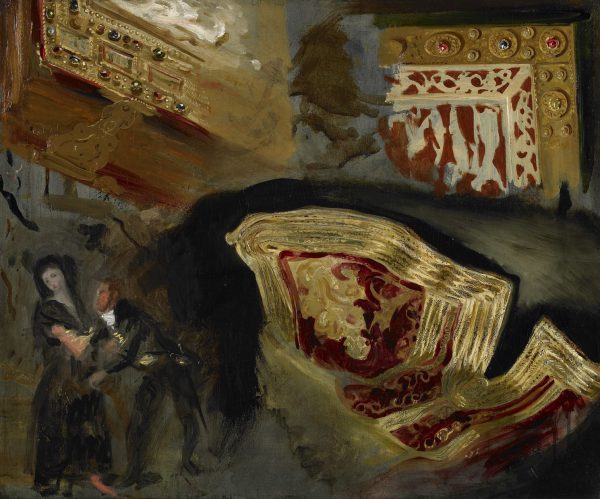Study of a suliot cloth, kontogouni missal covers and figures from Goya, Ca. 1822
Oil on canvas, H. 0.50 m; W. 0.61 m
On the back of the stretcher, upper centre, wax seal of the artist studio sale.
Provenance: Delacroix sale, Paris, February 17-18-19, 1864, probably part of no. 189 “Deux études d’après des armures, des casques et des cottes de mailles”.
Philippe Burty sale, March 2, 1891, lot 7 “Étude de deux personnages d’après Goya et sur la même toile une selle arabe et un antiphonaire”, 400 francs.
P.A. Cheramy sale, May 5, 1908, lot 188 “Etude de selle arabe et de personnages, d’après Goya. A droite et au fond, des broderies d’or sur velours rouge. A gauche deux figures esquissées. Une jeune femme debout qui semble repousser les assiduités d’un galant portant une épée.”, 1.800 francs, to Mrs Langweil.
Mrs Langweil collection.
Noufflard collection.
- Alfred Robaut, L’œuvre complet d’Eugène Delacroix, peintures, dessins, gravures, lithographies, Paris, 1885, n° 1919 : « Armures, casques, cottes de mailles. Deux toiles -Dimensions inconnues – n° 189 de la vente posthume, en deux lots : I° 520 fr à M. le comte Duchâtel ; 2 60 fr à M. Aubry. » Not catalogued by Moreau. In his catalogue conserved at the BNF, Alfred Robaut specifies in front of no. 1919: « l’une de ces toiles 40 x 60 cm à Mr Cheramy représente deux couvertures d’anciens missels, une veste turque et en bas à g. [gauche] une copie d’après Goya : Scène galante ».
- Lee Johnson, The paintings of Eugène Delacroix, vol. I. Oxford, 1981, (ed. 1987). p. 184, L34, mentioned as lost; vol. II, pl. 145 : the drawing by Robaut after Delacroix.
- Alain Daguerre de Hureaux, Delacroix, Paris, 1993, p. 331.
- Arlette Serullaz and Vincent Pomarède, Delacroix, la naissance d’un nouveau romantisme, Musée des Beaux-Arts de Rouen, 1998, p. 160, no. 113.
This study depicts a brocade embroided rock band of a Suliotic costume. The Suliotes are a Græco-Albanian race who gave valuable assistance to the Greeks in their struggle for independence. The Greek independence war against the Ottoman Empire had started in 1821, and people in Paris were more and more in favour of it. In September 1821, Delacroix wrote in a letter to a friend about his intention to paint a subject dealing with this war for the following Salon. His famous Massacre of Chios was finally shown in the Salon of 1824. A series of paintings including our study is to be dated between 1821 and 1824. In these years, Delacroix wrote in his Journal that he admired the costumes brought back from Greece and Asia by his friend, the painter Jules Robert Auguste. He used to borrow them from Auguste in order to copy them. It is likely that our study is one of these costumes.


